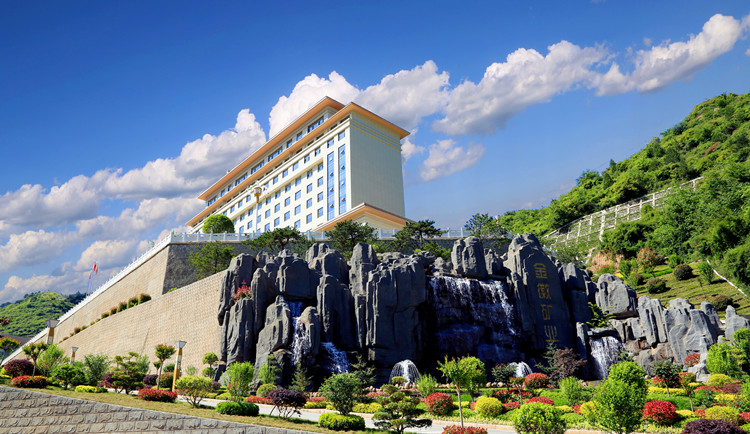来源:中国日报海外版
A played-out strip mine-an ugly environmental mess-was magically transformed in the United Kingdom by one man's vision, starting in the mid-1990s.
Today, words hardly do justice to the spectacular horticultural, educational and leisure destination known appropriately as the Eden Project, the brainchild of British environmentalist Tim Smit, which now stands near Cornwall in southwestern England. The project is an educational charity on an epic scale, connecting people to the living planet.
Massive climate-controlled geodesic domes, nestled in a crater, house the world's largest manmade rainforest. The grounds outside are lush and green, rivaling the moon Pandora of Avatar movie fame.
Now the Eden magic is coming to northern Tianjin, where authorities plan to transform a defunct coal mine from pit to paradise.
Affiliated with the mega project in England and guided by its experts, the Eden effort in Tianjin's Jizhou district is a pace-setting approach for dealing with thousands of mines in China that have been decommissioned because of concerns over environmental pollution-around 300 of them in Jizhou alone. Completion of the Tianjin project is scheduled for 2021.
What to do with such wastelands has been a puzzle. But now the authorities are catching Eden's vision of how to turn the sites into tourist attractions.
The Eden concept is even spreading beyond mine reclamation. In coastal Qingdao, Shandong province, and in inland Yan'an, Shaanxi province, for example, other kinds of land have been appropriated for similar facilities. In New Zealand and the United States, a similar approach has been adopted.
With an investment of 9 billion yuan ($1.28 billion), Jizhou's Eden project will cover 1.14 square kilometers, said Li Qun, an executive of Jizhou Urban Construction Investment Co, which is managing the project.
Li Jian, vice-director of the district, has "high hopes the project will lure 2 million tourists, create 10,000 jobs and generate tax revenues of up to 1 billion yuan within four years".
The Eden Project's UK version currently hosts more than a million visitors and has brought in about $2 billion.
Eden represents one of the more attractive solutions to the problem of defunct mines. Local governments are hurting from the loss of revenues after a massive wave of mine closings that began in 2017.
China Mineral Resources News said that by 2020, China will have closed up to 12,000 coal mines, a figure that's expected to balloon to 15,000 by 2030, because of environmental concerns.
Li Jian, Jizhou's vice-director, said the district has closed up to 12.46 square kilometers of mines, and an additional 50 sq km have been closed in surrounding areas.
"It is critical for us to deal with the deteriorating ecology and environment," Li said.
Since 2013, the district has been bulldozing the land flat at five major sites, but other projects require a more hefty investment.
Xiao Fei, senior engineer at the Tianjin North China Geological Exploration Bureau, said many of the closed mines in Jizhou and others around the country are located in ecological conservation zones, where it's much more difficult, and expensive, to undertake long-term conservation beyond basic surface rehabilitation.
Some mine areas initially turned green but then reverted because of a lack of sustained care. For example, all of the trees that had been planted at a closed 1.33-sq-km copper mine in the Tongguan Mountain area of Tongling, Anhui province, died just a year later.
If a mine is not located in a conservation zone, other concepts are possible. For instance, at a recent national mine summit in Tianjin, it was suggested that companies turn some rehabilitated mine sites into testing centers for driverless vehicles, a sector that's booming in China.
Even more innovative, a five-year plan for 2016-20 calls for building "smart mines", a concept that would make them more "digitalized, information-driven and intelligent".
In addition, nearly 700 Chinese companies began a "green mine" campaign in 2017 that combines production with environmentalism.
A prime example is Jin Hui Mining Co's operation in Longnan, Gansu province, which produces 1.5 million metric tons of lead and zinc annually using heavy equipment.
But if you visit the quiet, forestlike environment at the surface, you might not know the mine exists. A natural area beckons visitors, even as the digging machines work 800 meters below the surface, well out of earshot.
"We are proud of the fact that we can hear birds singing outside but cannot hear any noise produced by the machinery underground," said Zhang Shixin, a board member of the mining company and Party chief of Gansu Yatter Investment Group.
The site has been designated a national-level 4A scenic area, with 800,000 square meters of trees.
Jin Hui Mining Co was honored as the nation's first "green factory" by the Ministry of Industry and Information Technology and has become a role model for the province.
Randy Wright contributed to this story.

译文:
矿井转型给人们展示了伊甸园
从20世纪90年代中期开始,一个人的远见在英国神奇地改变了一个废弃的露天矿——一个丑陋的环境烂摊子。
如今,这个以园艺、教育和休闲著称的令人惊叹的目的地被称为“伊甸园计划”(Eden Project),是英国环保主义者蒂姆·斯密特(Tim Smit)的创意之作,位于英格兰西南部的康沃尔郡(Cornwall)附近。该项目是一个史诗级别的教育典范,展示了人类和所生活星球的联系。
巨大的可控制气候的弧形穹顶坐落在火山上,里面是世界上最大的人造雨林。外面的地面郁郁葱葱,绿意盎然,堪比电影《阿凡达》中的潘多拉星球。
如今,“伊甸园魔法”正在天津北部上演,当地政府计划将一座废弃的煤矿从矿井改造成天堂。
与英国的大型项目类似,在其专家的指导下,天津蓟州地区的伊甸园项目是处理中国数千座因涉及环境污染问题而被叫停的矿山的一种示范方法——仅在蓟州就有约300座矿山。天津项目预计2021年竣工。
如何处理这些地一直是个难题。但现在,当局正在学习“伊甸园计划”的方式,即如何将这些地方变成旅游景点。
伊甸园的概念甚至蔓延到矿山开垦之外。例如,在沿海的山东省青岛市和内陆的陕西省延安市,其他类型的土地也被用作类似的设施。新西兰和美国也采取了类似的做法。
蓟州城市建设投资有限公司负责伊甸园项目管理的李群说,蓟州的伊甸园项目将投资90亿元人民币(12.8亿美元),占地1.14平方公里。
该区副区长李建表示,“该项目有望在四年内吸引200万游客,创造1万个就业岗位,创造10亿元的税收收入。”
伊甸园计划的英国版目前接待了100多万游客,带来了大约20亿美元的收入。
伊甸是解决废弃矿区问题的较有吸引力的办法之一。自2017年以来,中国各地关闭了大批煤矿,地方政府正因此而收入受损。
《中国矿产资源报》称,由于环境问题,到2020年,中国将关闭多达1.2万个煤矿,到2030年,这一数字预计将激增至1.5万个。
蓟州副区长李建说,该地区已经关闭了12.46平方公里的煤矿,周边地区还关闭了50平方公里的煤矿。
李建说:“应对不断恶化的生态环境对我们来说至关重要。”
自2013年以来,该地区已经推平了五个主要地块,但其他项目需要更大的投资。
天津华北地质勘探局高级工程师肖飞表示,蓟州和全国各地许多已关闭的煤矿都位于生态保护区,在那里,除了基本的地表修复外,进行长期保护要困难得多,成本也高得多。
一些矿区最初变成绿色,但后来由于缺乏持续的照料而又恶化。例如,安徽省铜陵铜管山地区一处1.33平方公里关闭的铜矿,所有的树都在一年后死亡。
如果矿山不在保护区,则可以采用其他的概念。例如,最近在天津举行的一次全国矿业峰会上,有人建议企业将一些修复后的矿区改造成无人驾驶汽车的测试中心,这一领域在中国正蓬勃发展。
更有创新性的是,2016- 2020年的五年计划要求建设“智能矿山”,这一概念将使它们更加“数字化、信息化和智能化”。
此外,近700家中国企业在2017年发起了一场“绿色矿山”运动,将生产与环保结合起来。
一个典型的例子是甘肃陇南的金徽矿业公司,该公司使用重型设备每年处理150万吨的铅锌矿石。
但是,如果你来到这个安静的,环境像森林一样的地表,你可能不会知道这里是个矿区。天然的美景吸引着游客,采矿设备在地下800米处工作,地表完全听不到它们的声音。
“我们可以听到鸟儿的歌唱,但却听不到地下机器发出的任何噪音,这让我们感到自豪,”该矿业公司董事、甘肃亚特投资集团党委书记张世新表示。这里被评为国家4A级旅游景区,绿化面积80万平方米。金徽矿业有限责任公司被工业和信息化部评为全国首批“绿色工厂”。
 甘公网安备 62122702000156号
甘公网安备 62122702000156号